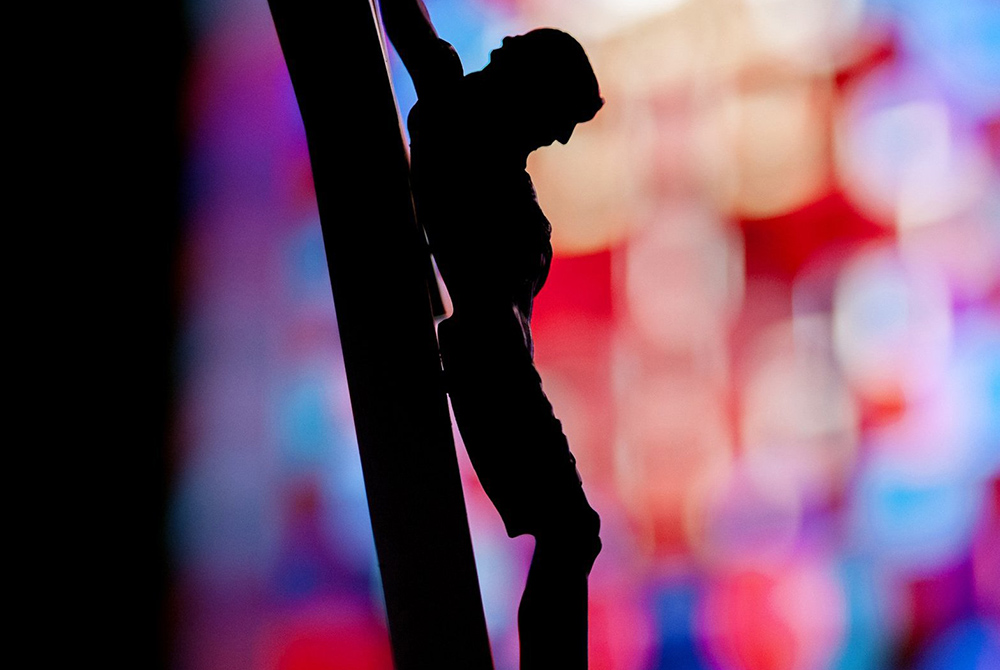
A crucifix is silhouetted against a stained-glass window in this illustration photo. (CNS/Mike Crupi, Catholic Courier)
Our presider, vested for Mass, was holding the church door open for all of us lined up to enter. He said to no one in particular, "These are tough times in the church and we're all being asked to do more." I laughed hard. It was our family's second trip back to Mass after we all had passed two weeks since our second vaccine dose. The whole experience is a little uncertain — the unfamiliarity of not having done it for more than a year added to a few lingering COVID-19 measures conspiring to make the whole experience a little odd. What should be familiar instead seemed a little foreign. The chance to laugh was welcome. And, I knew what he meant.
These are tough times in the church. We all know why. Priests and ministers do not know how many of us are coming back after the pandemic. Meanwhile, the U.S. bishops have picked a senseless fight with our second Catholic president. The abuse scandal continues to disillusion us. The church in Canada seems to be competing with U.S. bishops for an insensitivity prize. Around the globe, authoritarians who reject free politics have relationships to the church that are a little too close in too many cases. Pope Francis encounters opposition almost every time he opens his mouth. Catholicism is not a pretty picture in 2021.
During our 15 months away, like a lot of people I had time to reflect on what I was missing by being away from our parish for so long. Early in the pandemic I thought about what I came to think of as our American "sacramental affluence," the entitled sense that the Eucharist should be there and available for me whenever I want it.
A lot of the objections to public health measures that closed churches and limited attendance came from this sacramental affluence, a luxury of American Catholicism that is not a part of Catholic life in other parts of the world. Many of our brothers and sisters got more worked up about a Pachamama in the Vatican than they did about how women and men in South America sometimes wait a year for the Eucharist or more. Many of those same people were demanding regular Eucharist here in the U.S. during the pandemic, never seeing the plank in their eyes.
In a short period of time, if I am being honest, our family discovered we were not missing Mass at all. We missed the Eucharist, of course. But we had a home Liturgy of the Word every Sunday and on every holy day during the pandemic. In important ways, our liturgy was better. We were active ministers, all of us. We took turns proclaiming the readings. We renewed our baptismal promises each week. We heard reflections on the Scriptures from some of the most thoughtful Catholic women and men everywhere in the world.
This was the experience of the early church before Catholicism became an institution. Home church was church long before there ever was parish life. Our experience confirmed that it was a different, in some ways better Sunday observance that felt very Catholic.
Advertisement
After a few months, we began to realize something else. We had never heard from our parish (except twice when they appealed for money). I knew about some parishes that had organized phone trees to reach out to older or sick parishioners. Sometimes that gave an opportunity to pray or talk together on the phone. Other times, it was a chance to make sure someone who could not go out still got their groceries or prescriptions.
But we had no such calls, and my sense was that very, very few parishes were doing this kind of thing. I thought a lot about this, too. The men trained by our seminaries were trained to lead an American church they expected always would show up on Sundays. Very little seminary training (if any) prepares men to think of their ministry differently. There were priests who had enough pastoral sense, themselves, to know how to be ministers while their churches were empty. But the pandemic revealed how small their number is. I find myself wondering today how they will think about their ministries if very few of their parishioners come back at all.
That is the question of the moment, isn't it? Why go back? I have been asking it myself. And, though it's embarrassing to admit, I have not really had a ready answer. We have gone back. Mostly, I think, we were motivated by a sense of obligation. Thinking a lot about our church and our parishes during the long 15 months away did not yield many strong arguments to return, even for me —a "professional Catholic."
But the answer began to come back to me after our presider held the door at that second Mass. I began to get the answer when I began to notice what I had not experienced during all of those home liturgies across the long fifteen months. Babies crying. Footsteps in the aisles. Laughter coming up from the narthex. The clatter of hymnals being dropped or banged on pews. The whole, glorious mess of a Catholicism that means, "Here comes everybody." The cantor sang the offertory hymn, not one of my favorites. But the words caught my thoughts — "I see glory on each face/Surely the presence of the Lord is in this place."
This is our faith. This is the faith of the church. Beyond the seven sacraments, beyond the ministerial roles, beyond everything else lies a much deeper truth: What our faith tells us is that we encounter God together, in one another and when we assemble to hear the word and to receive the sacrament. Holiness comes from God. But we find it most frequently together when we are open to it. Parish life, for all its faults, prepares us to be receptive when holiness comes to find us.
I hope everyone will come back to the pews, eventually. But I have a much more important hope too. I hope that we will not forget our pandemic experience, and we will bring a new set of expectations to parish life. The best way to have a church worth coming back to is to build one. To build one together, that is.








